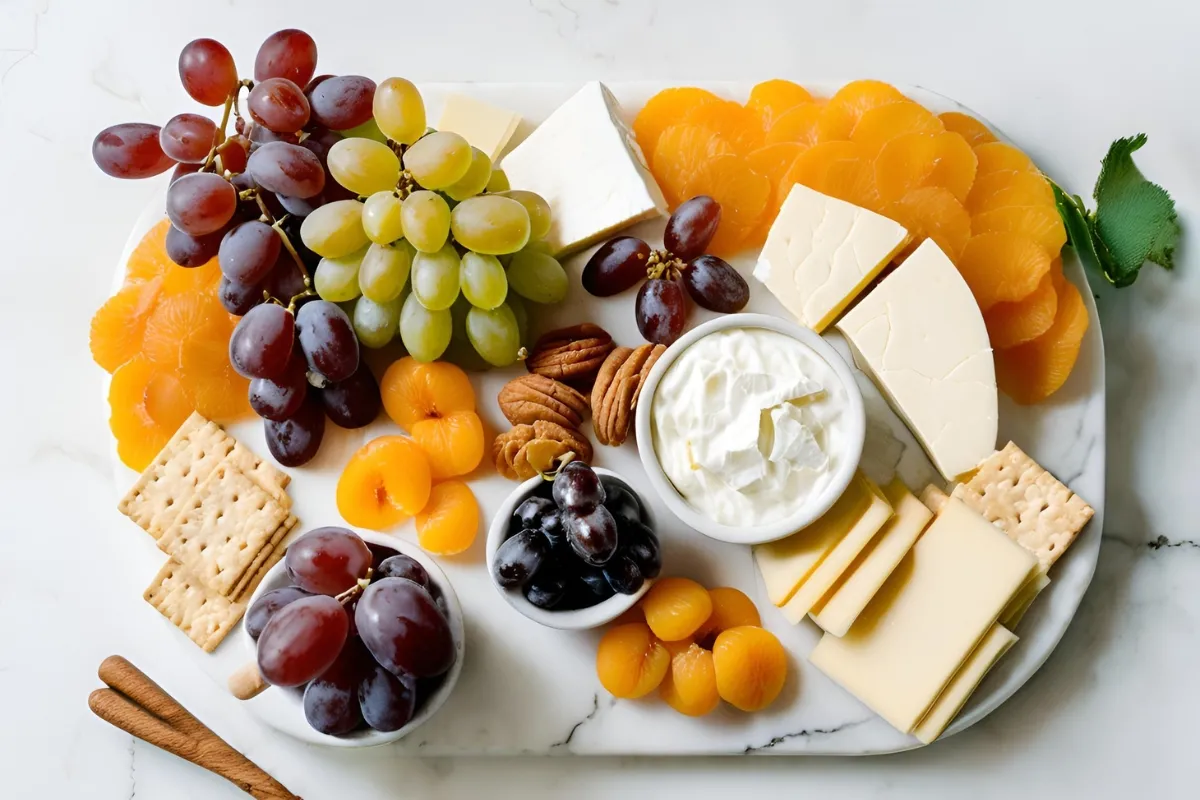Why Fruit and Cheese Platters Are a Timeless Choice
The Appeal of Sweet and Savory Pairings
There’s something magical about the combination of sweet fruits and savory cheeses. The moment a juicy slice of pear meets a wedge of creamy brie, or a tangy grape bursts alongside a sharp cheddar, your taste buds get an unexpected thrill. It’s a balance of contrasts—soft with crunchy, sweet with salty, bold with mild—that makes every bite feel like a little adventure. This mix of flavors and textures turns an ordinary snack into a memorable experience.
Moreover, fruit and cheese platters aren’t just delicious—they’re versatile. Whether you’re hosting a laid-back movie night, an elegant dinner party, or even brunch with friends, a well-curated platter works for any occasion. It’s like that go-to outfit in your closet—always the right fit.
Occasions Perfect for a Fruit and Cheese Platter
Let’s be honest: there’s no bad time for a fruit and cheese platter. But some moments feel tailor-made for this pairing. Think festive holiday gatherings where a colorful spread doubles as both an appetizer and a centerpiece. Picture a breezy summer picnic, with fresh berries and creamy goat cheese complementing the sunshine. And don’t forget romantic date nights or wine tastings with friends—nothing screams “I’ve got my life together” quite like a beautifully arranged board.
Understanding the Balance of Flavors
How Texture and Taste Play a Role
When you’re building a fruit and cheese platter, balance is everything. For example, pairing a rich and buttery cheese like brie with crisp green apples creates a satisfying contrast. Or, for a more adventurous vibe, try combining crumbly blue cheese with the smooth sweetness of ripe figs. Mixing textures—like creamy, crunchy, juicy, and chewy—keeps the palate intrigued and makes the platter a joy to eat.
Taste balance matters, too. Sweet fruits like strawberries or honey-drizzled peaches can tone down the saltiness of hard cheeses like parmesan. On the other hand, tangy fruits like citrus slices can enhance the nuttiness of aged gouda. This interplay of flavors is what makes every bite exciting.
The Importance of Visual Presentation
Let’s not kid ourselves—half the appeal of a fruit and cheese platter is how stunning it looks. Think vibrant reds and purples from berries and grapes, paired with golden slices of pineapple or kiwi’s brilliant green. When arranged with care, a platter becomes more than just food—it’s art. Plus, a beautiful spread is practically begging to be Instagrammed (because, let’s face it, we all love a good #FoodieMoment).
Who Can Enjoy a Fruit and Cheese Platter?
From Connoisseurs to Casual Entertainers
The best part about fruit and cheese platters? They’re for everyone. If you’re a cheese aficionado who can pronounce “Taleggio” without Googling it, you’ll appreciate the nuanced flavors. If you’re someone who just wants an easy yet impressive snack for game night, a fruit and cheese platter has your back.
It’s also great for any age group. Little ones might go wild for cheddar cubes and apple slices, while grown-ups sip wine alongside brie and blueberries. And for those with sophisticated palates, adding exotic fruits or aged cheeses will elevate the experience (oops, I said “elevate”—scratch that, enhance the experience).
Dietary Considerations and Customization
With so many options, a fruit and cheese platter can cater to almost any dietary preference. For example, plant-based guests can enjoy platters featuring vegan cheeses and fresh fruit. Gluten-free crackers or seed crisps can keep things inclusive for everyone. Even low-carb enthusiasts will find joy in pairing rich cheeses with a selection of keto-friendly berries.
Beyond dietary needs, the platter can reflect your unique style. Want a tropical vibe? Add mango slices, papaya, and creamy havarti. Feeling festive? Try dried cranberries, candied nuts, and rosemary sprigs for a wintery look. Customization is key—and honestly, kind of the fun part.
Essential Components of a Cheese and Fruit Platter
Selecting the Right Cheeses for Your Platter
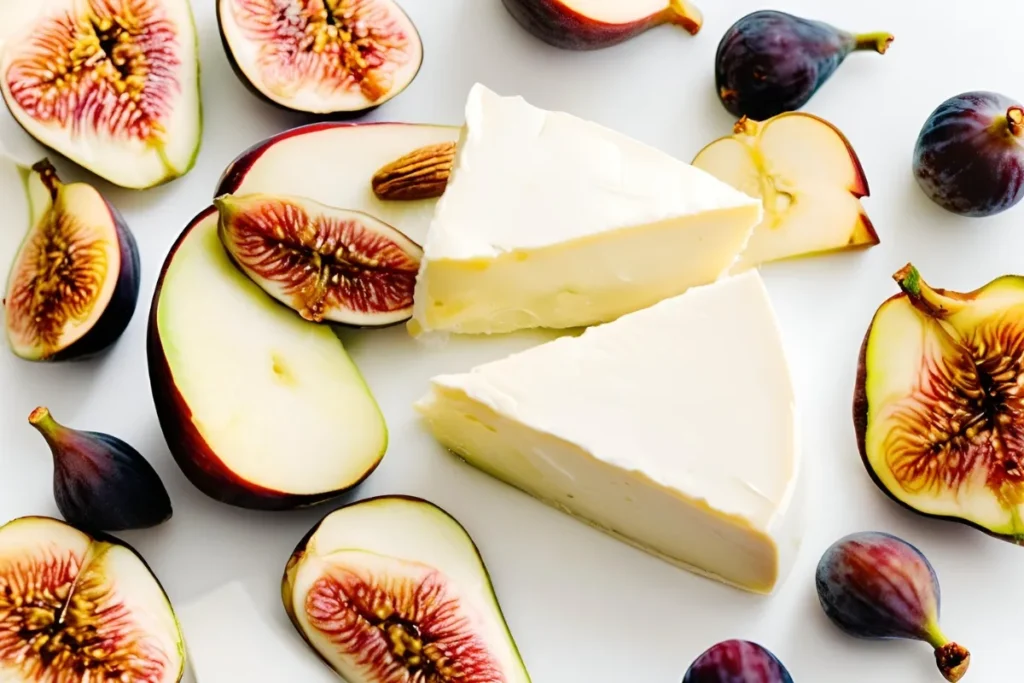
The key to a memorable fruit and cheese platter lies in your cheese selection. A good variety ensures there’s something for every taste bud. Let’s break it down:
Soft Cheeses (e.g., Brie, Camembert)
Soft cheeses are the heart of any cheese board. Brie, with its creamy texture and mild flavor, pairs beautifully with sweet fruits like strawberries or figs. Camembert offers a slightly more intense flavor, making it a match made in heaven for juicy grapes or honey-drizzled apples. These cheeses add a luxurious feel to your platter, not to mention that they spread perfectly on crackers or crostini.
Hard Cheeses (e.g., Aged Cheddar, Parmesan)
For a cheese that brings a savory punch, look no further than hard cheeses. Aged cheddar’s sharpness complements the sweetness of pears or dried apricots, while parmesan’s nutty undertones shine alongside tangy fruits like pineapple. These cheeses also bring structure to your board, creating a satisfying contrast to softer options.
Blue Cheeses for the Bold Palate
If you want to spice things up (literally), blue cheese is the way to go. Its distinct, tangy flavor works wonders with the sweetness of honey or the rich juiciness of fresh figs. Not everyone loves blue cheese, but for those who do, it’s often the star of the show. A little goes a long way—just a small wedge can add depth to your platter.
Ideal Fruits for Pairing with Cheese
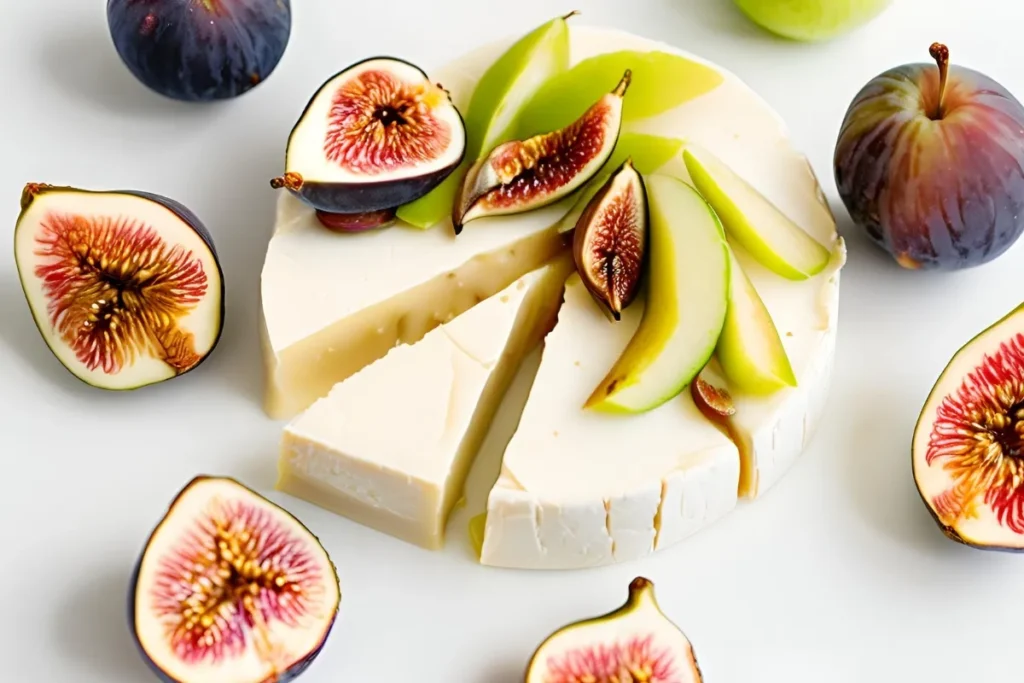
Just like the cheese, your fruit selection needs variety in both flavor and texture.
Fresh Fruits (e.g., Grapes, Berries, Figs)
Fresh fruits are the MVPs of a cheese platter. Grapes, with their natural sweetness and pop of juiciness, are practically a cheese platter tradition. Berries like raspberries, blackberries, and blueberries bring a vibrant tartness that cuts through rich cheeses like brie or goat cheese. And figs? Their honey-like sweetness feels downright decadent when paired with creamy cheeses.
Dried Fruits (e.g., Apricots, Raisins)
Dried fruits add a chewy texture and concentrated sweetness that pairs well with sharper cheeses. Dried apricots, for instance, bring out the nutty undertones in gouda, while raisins or golden sultanas complement the saltiness of parmesan or pecorino. They’re also easy to store and don’t require much prep, making them a convenient choice.
Exotic Choices (e.g., Starfruit, Dragon Fruit)
For those who want to impress, adding exotic fruits like starfruit or dragon fruit can make your platter stand out. Their unique shapes and colors don’t just taste great—they also double as a conversation starter. Starfruit’s crisp texture works well with creamy cheeses, while dragon fruit’s mild sweetness can balance bold flavors like blue cheese.
Balancing Flavors and Textures
Contrasting Sweet, Salty, and Tangy Elements
The secret to a great platter is contrast. Pairing sweet elements, like honey or fresh fruit, with salty cheeses creates a harmony of flavors. Similarly, tangy options, like citrus slices or pickled fruit, can cut through the richness of creamier cheeses.
For example, a slice of aged cheddar with a dab of fig jam creates a sweet and salty explosion. Or consider pairing a soft goat cheese with a sprinkle of pomegranate seeds for a tangy twist. The possibilities are endless, and playing with different combinations is part of the fun.
Incorporating Crunchy Additions (e.g., Nuts, Crackers)
Crunchy elements like nuts and crackers are a must-have. Almonds, walnuts, or pecans add texture and complement both the fruit and cheese. For an extra indulgence, try candied nuts or spiced varieties.
Crackers and breadsticks are not just for serving—they’re flavor vehicles. Choose neutral crackers that let the cheese and fruit shine, or opt for seeded options for added crunch. Just be sure to offer a variety so your guests can mix and match to their liking.
Adding Sweet Enhancements (e.g., Honey, Jams)
Drizzling honey over blue cheese or brie is a game-changer—it’s simple yet oh-so-satisfying. Similarly, jams and preserves (like apricot, raspberry, or fig) elevate the sweetness factor. These extras not only taste amazing but also bring visual appeal to your platter with their rich, glossy appearance.
What Makes Good Fruit and Cheese Combinations?
Classic Matches (e.g., Brie and Apples)
Some pairings are classics for a reason. Brie and apples are a match that hits all the right notes—creamy, crisp, sweet, and slightly tart. Another timeless combo? Blue cheese and pears, which bring together bold flavors and natural sweetness. For a foolproof option, try goat cheese with dried cranberries or cherries.
Unique Pairings to Surprise Your Guests
If you want to wow your guests, go for unexpected combinations. Think manchego with slices of quince or a tropical twist like gouda paired with mango. For a playful experiment, try pairing creamy ricotta with watermelon or a dollop of mascarpone with passionfruit pulp. These unusual combinations can make your platter a memorable culinary adventure.
Tips for Arranging a Visually Striking Platter
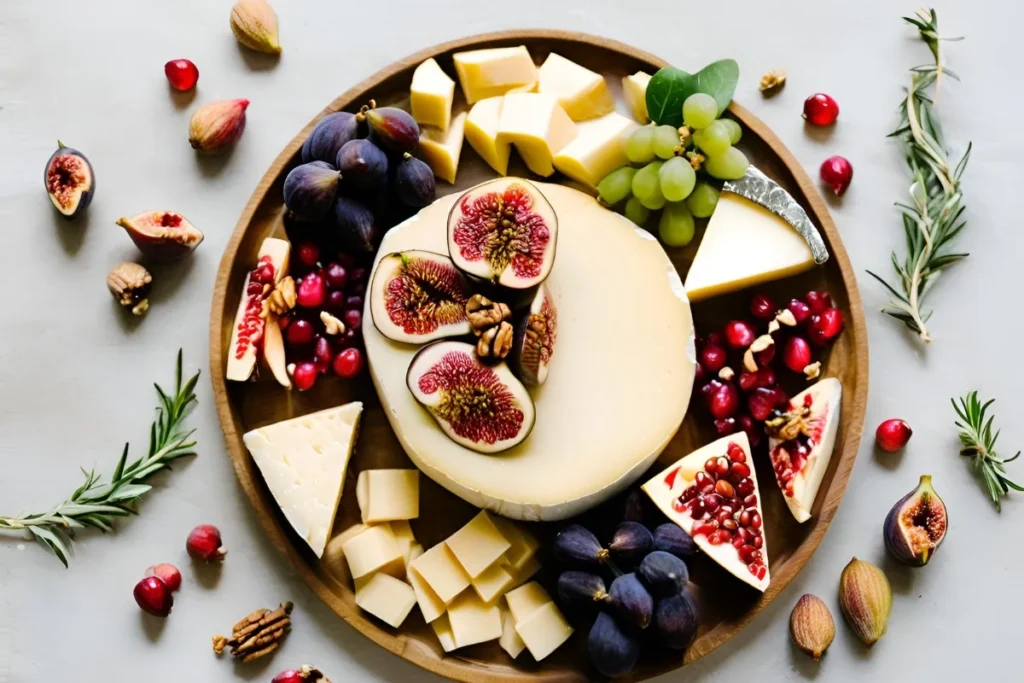
Using Shapes and Colors for Aesthetic Appeal
The first rule of a beautiful fruit and cheese platter? Think like an artist. Use the colors, shapes, and textures of your ingredients to create a display that’s not just delicious but also eye-catching. For example, arrange deep purple grapes next to creamy white brie for contrast, or place vibrant orange apricots alongside green apple slices.
Layering and variety also play a big role in presentation. Stack cracker rows neatly, fan out apple slices, and pile berries into little clusters for a natural look. And don’t be afraid to let some elements overlap—it creates a sense of abundance that feels inviting.
Layering and Grouping Techniques
Grouping similar items together makes your platter more organized and approachable. For instance, place all your cheeses in separate sections, surrounded by their complementary fruits. Keep dried fruits in little piles and nuts sprinkled in the gaps for a cohesive yet dynamic look.
Layering adds dimension. Stack small wedges of cheese on top of larger ones, or elevate certain items using a small bowl or pedestal. For a final touch, add sprigs of herbs like rosemary or thyme for a pop of green and a touch of elegance.
Preparing Your Ingredients Ahead of Time
How to Cut and Store Fruits Without Losing Freshness
Preparing fruits in advance can save time, but keeping them fresh is crucial. For apples, pears, or other fruits prone to browning, dip the slices in a mixture of water and lemon juice. This simple trick preserves their color and keeps them looking vibrant.
Soft fruits like berries or figs should be washed and dried thoroughly before arranging them. If possible, store them in the refrigerator until just before serving to maintain their juiciness and texture. To avoid wilting or drying out, cover the prepped fruits with a damp paper towel.
Preserving the Flavor and Texture of Cheese
Cheese is best served at room temperature, so plan to take it out of the fridge about 30 minutes before your guests arrive. However, if you’re prepping ahead, store cheeses tightly wrapped in parchment paper or beeswax wrap to let them breathe while maintaining their moisture.
For softer cheeses like brie or goat cheese, keep them in their original containers or place them in airtight packaging to prevent drying. Harder cheeses can be pre-sliced and stored in resealable bags, making them easy to grab and arrange when it’s time to set up the platter.
Hosting Ideas and Serving Suggestions
Beverage Pairings for Fruit and Cheese
Wine, Cocktails, and Non-Alcoholic Options
Pairing drinks with your fruit and cheese platter takes the experience to the next level. A crisp white wine like Sauvignon Blanc complements creamy cheeses and fresh fruits like peaches or pears. For red wine lovers, a Merlot or Cabernet Sauvignon works beautifully with hard cheeses and dried fruits.
If cocktails are more your vibe, a light gin and tonic with a twist of citrus pairs well with tangy cheeses. And don’t forget non-alcoholic options! Sparkling water with a splash of cranberry juice or a fresh mint lemonade can be just as refreshing and complementary.
Creative Themes for Your Platter Presentation
Seasonal Platters (e.g., Fall Harvest, Spring Blossoms)
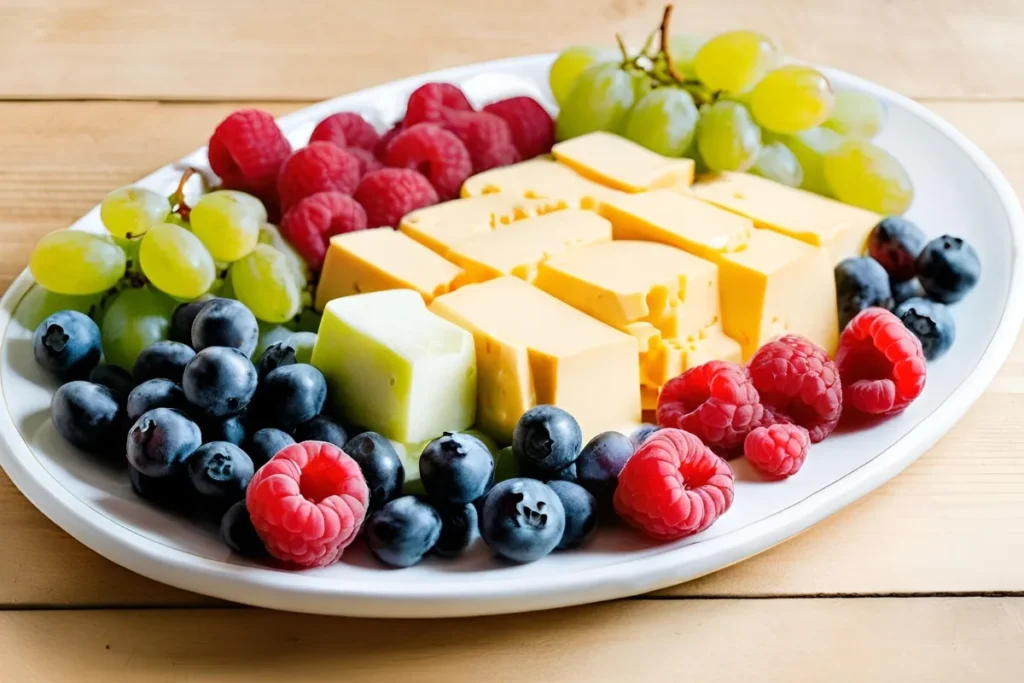
Let the season guide your ingredients and aesthetic. For fall, focus on rich, earthy tones with figs, pomegranates, and a mix of cheddar and gouda. Add walnuts, dried cranberries, and a drizzle of maple syrup for a cozy touch.
Spring platters, on the other hand, call for light and bright vibes. Think fresh strawberries, kiwi, and goat cheese garnished with edible flowers for a whimsical, garden-party feel.
Regional Inspirations (e.g., Mediterranean, French Bistro)
Channeling a specific region is another way to make your platter stand out. A Mediterranean board might feature feta, olives, and fresh herbs like oregano, paired with dried apricots and pita chips. For a French-inspired spread, lean into brie, camembert, and blue cheeses, paired with baguette slices and a drizzle of honey.
Future Trends in Cheese and Fruit Platters
Sustainability and Locally Sourced Ingredients
Sustainable choices are becoming increasingly popular—and for good reason. Opting for locally sourced cheeses and fruits not only supports nearby farmers but also ensures fresher, more flavorful ingredients. Plus, it reduces the carbon footprint of your platter, which is a win-win for you and the planet.
Consider seasonal offerings, too. Choosing fruits and cheeses that are in season not only enhances the quality but also adds a touch of authenticity to your board.
Incorporating Plant-Based Cheese Alternatives
With the rise of plant-based diets, vegan cheeses are stepping into the spotlight. Made from nuts, soy, or even coconut, these alternatives come in a variety of flavors and textures that rival traditional cheeses. Pair cashew-based brie with dried apricots or almond ricotta with fresh figs for a platter that’s inclusive and delicious.
Final Thoughts on the Joy of Fruit and Cheese Platters
The Timeless Appeal of a Well-Curated Platter
Fruit and cheese platters have been a staple for generations—and for good reason. They’re endlessly customizable, visually stunning, and perfect for almost any occasion. Whether you’re entertaining friends or treating yourself, there’s something special about savoring a platter filled with thoughtfully paired ingredients.
Encouraging Creativity in Your Culinary Adventures
At the end of the day, building a fruit and cheese platter is an art form. It’s an opportunity to get creative, experiment with flavors, and express your personal style. So don’t be afraid to try new combinations, add unexpected elements, or play around with presentation. The best platters are the ones that reflect your unique taste and bring joy to everyone who shares them.
FAQs
What Goes on a Cheese and Fruit Platter?
Must-Have Cheeses and Fruits
A great cheese and fruit platter starts with variety. For cheese, include a mix of soft (like brie or goat cheese), hard (aged cheddar or gouda), and bold options (blue cheese or stilton). On the fruit side, fresh picks like grapes, berries, and apples are essential. Add a few dried fruits, such as apricots or figs, to create depth and balance.
The best platters also include accompaniments that enhance the flavor experience. Think crackers, crusty bread, or even pretzel bites. Sweet extras like honey and jam round out the platter, making each bite satisfying and unique.
Optional Additions to Elevate Your Platter
To take your platter to the next level, consider a few extras. Nuts, such as almonds or pecans, add crunch. For something savory, include olives or cured meats like prosciutto. Garnishes like fresh rosemary sprigs or edible flowers not only add flavor but also make the platter visually stunning.
What Are Good Fruit and Cheese Combinations?
Popular Pairings for All Tastes
Certain combinations are crowd-pleasers for a reason. Brie with apple slices is a classic—it’s creamy, crisp, and just sweet enough. Blue cheese with pears offers a bold flavor pairing, while goat cheese with strawberries creates a fresh, tangy balance. For something a little richer, try cheddar with dried apricots.
How to Experiment with New Flavor Profiles
Don’t be afraid to get creative with your combinations! Try manchego with quince paste for a sweet and savory Spanish-inspired match. Or, for something tropical, pair fresh pineapple with gouda. Mixing unusual ingredients, like mascarpone and passionfruit pulp, can introduce your guests to new flavor adventures they’ll rave about.
What Fruit Can You Put on a Cheese Board?
Fresh, Seasonal, and Exotic Options
The beauty of a cheese board is that nearly any fruit works! In-season fruits are ideal because they’re at their peak flavor and look their best. Classic choices like grapes, berries, and apples are always a win.
For something exotic, consider dragon fruit, starfruit, or lychee. These fruits not only add a unique taste but also give your platter a striking visual element. Plus, using less common fruits can spark conversations and impress your guests.
The Role of Dried and Preserved Fruits
Dried fruits like apricots, figs, and raisins are perfect for adding chewiness and concentrated sweetness to your board. They pair well with sharp or salty cheeses, making them a go-to addition. Preserved fruits, such as candied orange peel or fig spread, can also enhance the platter by introducing more intense, layered flavors.
Can You Cut a Fruit Platter the Night Before?
Best Practices for Prepping in Advance
Yes, you can absolutely cut fruit ahead of time, but keeping it fresh is key. Start by selecting fruits that hold up well, like grapes, berries, or citrus. For fruits prone to browning, such as apples or pears, toss the slices in lemon water to maintain their vibrant color. Store everything in airtight containers in the fridge until you’re ready to serve.
Tips for Keeping Fruits Fresh and Vibrant
To keep fruits looking their best, avoid cutting them too thinly—thicker slices retain moisture longer. Wrap delicate items, like fresh berries, in paper towels to absorb excess moisture. When storing, separate each fruit type to prevent cross-flavoring. With these tricks, your fruit platter will look as good as it tastes, even if prepped the night before.

